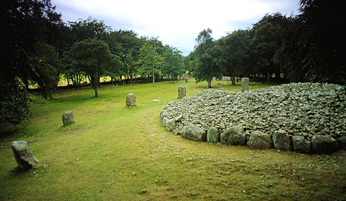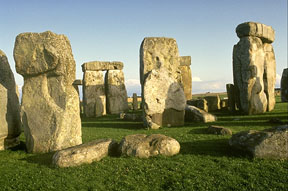This photograph shows the stones of Stonehenge up close. Stonehenge is the most well known megalithic structure.
Click on image for full size
Image courtesy of Corel Photography
What are Megaliths?
Have you ever seen a megalith? Maybe you have and you just didn't know it!
A megalith is made of huge stones. They were put together by ancient people. Sometimes the stones look like a stone fort and sometimes they are just rocks that have been stood on end. Other megaliths look like big mounds of rocks, but those mounds have secret chambers inside of them!
Megaliths can be found all over. They are in Europe, Russia, the Americas, Africa, and Asia.
Some megaliths were road markers like our present-day road signs. Some were probably ancient sites of worship. Still others were graveyards. And others might have been astronomy observatories.
We do know that these structures must have been really important to the people who built them! Some of the megaliths are almost 7,000 years old. That means that 7,000 years ago people were moving stones of up to 180 tons in weight around. They did that without cranes or trucks or even simple horse-drawn carts!
The most famous megalithic site is Stonehenge in England. But there are other cool ones too. Take a look at Newgrange of Ireland, Balnuaran of Clava in Scotland, Pentre Ifan in Wales, the stones of Fossa in Italy and the Carnac stones of France.
You might also be interested in:

Ancient people all over the world built stone structures. Some of the stone structures marked graveyards for these people. In Wales, there are some stones named Pentre Ifan that mark a grave. There is
...more
The stones of Carnac, France, are very famous because there are a lot of them and because they are so old! The oldest stones found in Carnac are from about 4,500 B.C. That's older than the stones at Stonehenge!
...more
You may have heard of the lake called Loch Ness, where people think they've seen the Loch Ness monster. Near Loch Ness there are three giant stone tombs you may not have heard of...they are called the
...more
There are over 900 rings of stone located in the British Isles. The most famous of these stone rings is Stonehenge. Stonehenge is in England. Stonehenge is a mysterious sight. There's these huge stones
...more
The stone rings and tombs of England and France are very famous. But, there are also stone structures in Italy. There are some neat stones in Fossa, Italy. They are standing stones. These stones form circles
...more
Simple astronomy was probably practiced at Stonehenge over 4,000 years ago. These ancient observers would especially observe the movement of the Sun and Moon across the sky. Stonehenge actually lines up
...more
Man has always observed the sky. By watching the Sun and Moon, early man could tell what season was coming next. They had to know this to be able to farm and hunt. Archeoastronomy started in the 1960's
...more















